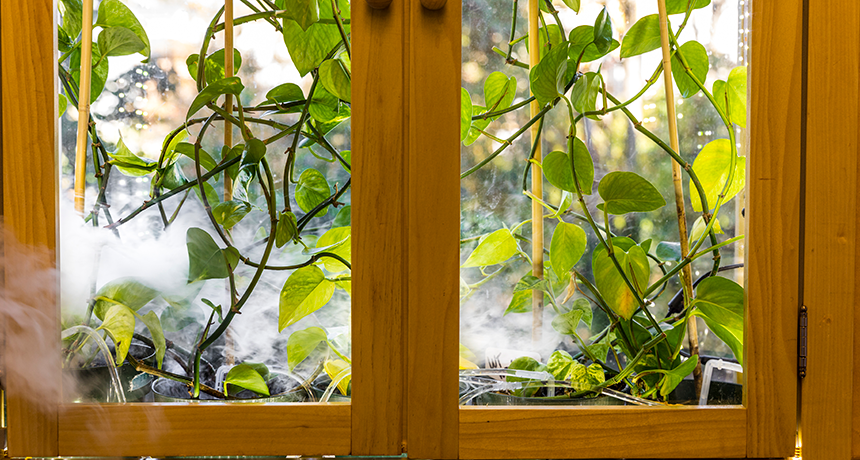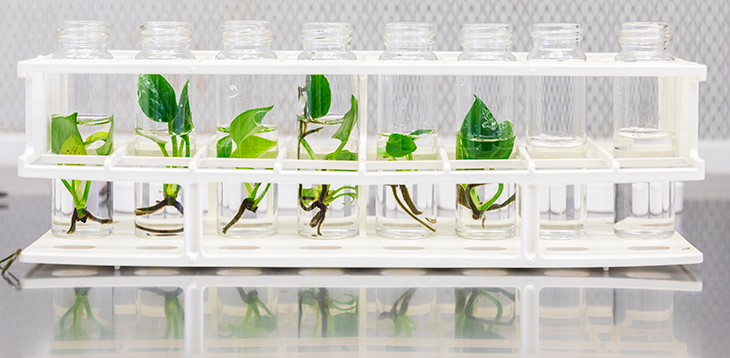This houseplant can clean indoor air
Adding a rabbit gene helps this ivy break down cancer-causing chemicals

Plants behind the doors of this greenhouse are breaking down harmful chemicals that pollute indoor air.
Mark Stone/University of Washington
Share this:
- Share via email (Opens in new window) Email
- Click to share on Facebook (Opens in new window) Facebook
- Click to share on X (Opens in new window) X
- Click to share on Pinterest (Opens in new window) Pinterest
- Click to share on Reddit (Opens in new window) Reddit
- Share to Google Classroom (Opens in new window) Google Classroom
- Click to print (Opens in new window) Print
By Diana Crow
Cleaning supplies, paints, glues and other items can release harmful chemicals into indoor air. Removing them from that air can be tricky and expensive. But Stuart Strand thinks houseplants may be able to help.
Strand is an engineer at the University of Washington in Seattle. He studies ways to clean up the environment using plants and other living things.
The idea he’s working with is hardly new. NASA researchers first proposed it in the 1980s. When plants take in air through their leaves, they can use proteins called enzymes to disarm toxic chemicals. But most enzymes only work on a few types of chemicals. And plants may not have enzymes that tackle each of the pollutants in their environment. So plants’ usefulness for cleaning up pollution is limited without some help from scientists.
Strand’s team decided to work with a houseplant called pothos (POH-thoes) ivy. They boosted its pollution-breakdown ability by adding a pollution-busting gene. In tests, this altered plant removed some pollution from the air.
Strand hopes such plants will help tackle the widespread problem of home air pollution. Indoor levels of those chemicals tend to be small. But if people breathe them in every day for years and year, they might lead to disease, such as cancer. Small children and teens may get extra-large doses if they spend more time at home than their parents.
Strand’s team starting by giving plants the gene to make an enzyme called 2E1. It’s a liver enzyme shared by all mammals, including people. They used the rabbit version of this gene because they had worked with it before.
This enzyme targets small, carbon-rich molecules called VOCs. (That stands for volatile organic compounds.) VOCs are a big problem. Because they turn into a gas at room temperature, they are fairly easy to inhale. Once in our bodies, VOCs can cause breathing troubles and other problems. They can also damage DNA, increasing the risk of cancer.
Inside the liver, 2E1 can break down VOCs at the molecular level. Strand’s team wanted to know whether this liver enzyme would do the same thing inside a leaf. The good news, they found: It does.
One tough plant
The researchers chose to work with pothos ivy — also known as “devil’s ivy” — because it’s already a popular houseplant. “Even I can’t kill pothos ivy,” Strand says, “and I’m not very good with houseplants.”
They took baby plants that were only a few centimeters tall and put them in bottles. The bottles held just some water, a few nutrients and air.
After sealing the bottles, the researchers injected one of two common indoor VOCs into each bottle. Some bottles received benzene (BEN-zeen). It’s a common ring-shaped carbon-based chemical found in many things, including gasoline. Benzene often enters homes through attached garages. Other bottles got chloroform (KLOR-oh-form). This chemical forms in chlorine-treated water, like tap water. It can escape into the air during hot showers.

Strand’s team also set up bottles with regular pothos ivy, and bottles with no plant at all. They let all the bottles sit in the lab for more than a week. Each day, the scientists sampled the air inside the bottles. They ran these samples through a machine called a gas chromatograph (Kroh-MAT-uh-graf). It can identify the chemicals in air.
All the chloroform bottles started out with the same amount of the gas. In bottles with the gene-altered ivy, chloroform levels fell 82 percent within three days. Chloroform levels in bottles with regular plants barely budged.
Results with benzene were similar. Its level in bottles with normal pothos dropped slightly over eight days (due to small leaks). It did the same in plant-free bottles. But in bottles with ivy able to make the 2E1 enzyme, benzene plunged by about 75 percent.
Strand and his colleagues shared their findings January 2 in Environmental Science & Technology.
Cleaning house
The results of the experiment confirm that adding 2E1 helped pothos ivy break down common VOCs. But cleaning all the air inside a tiny bottle is easier than detoxifying an entire house.
For one thing, houses and apartments are much bigger. Indeed, a plant in the living room may not be able to clean up air in the kitchen. “If you want to remove [toxic pollutants] from the air and you really want to do it well, you’ve got to move the air past the plants,” Strand says. “You can’t just have the plant sitting over there in a corner.”
VOC levels in homes tend to be much lower than those that Strand’s team tested. The researchers will need to try the ivy in air with very, very small amounts of VOCs, says M. Carmen Martínez. A plant biologist, she works at the Autonomous University of Barcelona in Spain.
In fact, Strand’s team is doing tests to find out whether ivy with the 2E1 gene can clean air in real-world homes. If it works, they hope one day to sell these plants in stores.
Still, there’s one more hurdle such plants will need to clear, says Majbrit Dela Cruz. And that is whether people will be willing to use them.
Dela Cruz is a biologist at the University of Copenhagen in Denmark. She studies how plants interact with chemicals, although not as part of this study. Some people distrust genetically modified organisms, also called GMOs, she notes. They may worry that adding genes to plants will have unexpected effects. Or they may fear that houseplants with rabbit genes will escape into the environment.
Strand will have to prove that 2E1 ivy won’t spread its genes outdoors before getting approval to sell it in the United States. (Pothos ivy can’t survive in cold weather, so in many places it wouldn’t live long enough to cause problems.) Even then, some people may not be willing to bring a plant with rabbit genes into their home. “Whether it’s of use in our homes,” says Dela Cruz, will depend “on whether people will accept that.”







